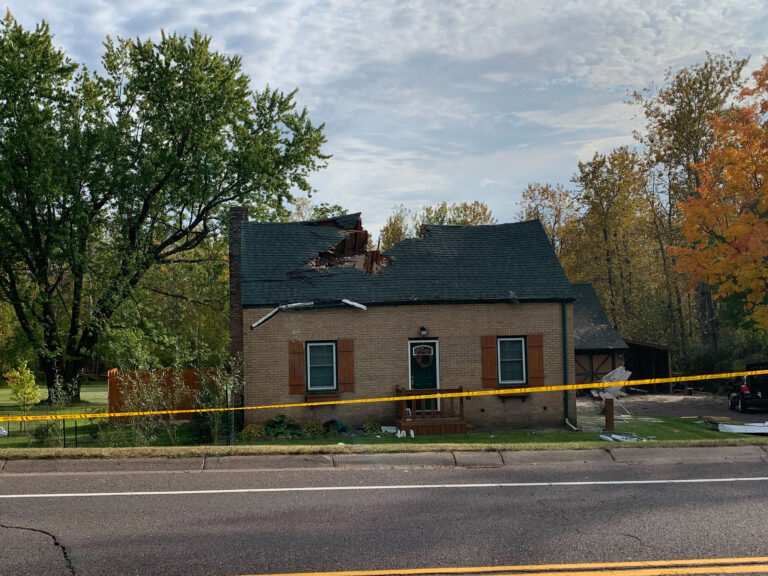
The pilot of a single-engine plane that crashed into a house in Hermantown in 2022 — killing the three people on board but not the homeowners — had expressed before the flight that he was “not confident about his instrument flying abilities,” according to the final report from the NTSB.
The plane, flown by Tyler Fretland, 32, of Burnsville left Duluth International Airport en route to South St. Paul late on Oct. 1, 2022, following a wedding. Four minutes later, the plane crashed into electrical wires, then the two-story brick home on Arrowhead Road. Jason and Crystal Hoffman, who were asleep at the time of impact, escaped with just scrapes, but the high school sweethearts’ dream home was destroyed.
It’s likely that Fretland experienced “spatial disorientation” — an aviation term referring to an inability to sense positioning in context to the earth, according a report issued by the National Transportation Safety Board. There was no evidence of mechanical failure before the crash.
The probable cause: “The pilot’s loss of airplane control due to spatial disorientation during initial climb in dark night and low instrument meteorological conditions, which resulted in a descent into terrain,” according to the report. “Contributing to the accident was the pilot’s fatigue due to a long day of flying and personal activities.”
Passengers Alyssa Schmidt, 32, of St. Paul, and Matthew Schmidt, 31, of Burnsville, who were siblings, died alongside Fretland in the crash. Alyssa Schmidt was a second-grade teacher at Echo Park Elementary School of Leadership, Engineering and Technology in Burnsville. She was remembered as a bubbly, free spirit.
Matthew Schmidt was also part of the flying community, according to his obituary, which said he had “discovered what made him feel alive.”
Fretland had been interested in flying since he was a kid and dreamed of working for Delta Air Lines. He had a commercial pilot certificate and flight instructor certificate with 645.9 hours of flight experience.
It was a “night instrument flight rules” trip, meaning the pilot was dependent on the instruments in the cockpit rather than external visual cues. The clouds were low to the ground, visibility was reduced and it was misting lightly. The pilot ascended to a height where ground lights would have disappeared, according to the report.
The day before the accident, the pilot and a student flew on a night cross-country flight. Fretland reportedly told the student that he was flying to a wedding the following morning and was nervous because he wasn’t confident in his instrument flying abilities. He had 7.9 hours of instrument flight experience, .3 hours in the past 15 months.
According to the report, the plane briefly leveled at 2,800 feet before it began its rapid descent. Fretland had one more moment of contact with air traffic control, then did not respond to further communications. The plane likely hit the Hoffman’s house at a 40-degree left bank.
As part of its report, the NTSB examined videos of the takeoff taken by the passengers, which showed the climb to 1,500 feet, condensation on the inside windows, no abnormalities on the instrument panel, and normal sounds from the plane’s engine.
The video ended at 24 seconds, after the plane had entered the clouds.
Jason and Crystal Hoffman and their diabetic cat Zuzu moved from Hermantown to South Range, Wis., after the accident that destroyed nearly all their belongings, in addition to their home. On the night of the crash, they woke to airplane parts at the foot of their bed, a destroyed stairway and the back side of the house blown out.
The house, one of 84 built in Hermantown as part of the Jackson Project, was torn down and the couple sold the land. The brick Jackson Project houses were built in the late 1930s, a plan to move people who were struggling financially from urban to rural spaces, where they had space to grow their own food.
Jason Hoffman said he saw the NTSB’s report a few days ago.
“We’ve been so curious about what happened,” he said Tuesday. “We keep thinking about those families, kept wondering for two years.”
In the immediate aftermath, he said the couple struggled with “night booms,” where they heard the crash over and over again, in addition to survivors’ guilt. Things have settled down as time has passed. Now the only unfinished business is recouping losses from insurance companies. They’ve hired lawyers.
___
© 2024 The Minnesota Star Tribune
Distributed by Tribune Content Agency, LLC.
0 comments :
Post a Comment